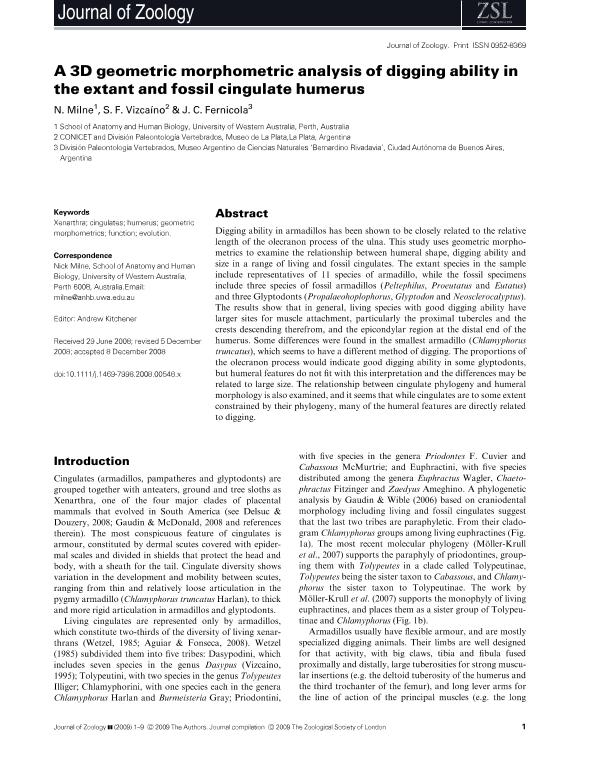Mostrar el registro sencillo del ítem
dc.contributor.author
Milne, Natalia Romina

dc.contributor.author
Vizcaíno, Sergio Fabián

dc.contributor.author
Fernicola, Juan Carlos

dc.date.available
2021-12-14T13:07:49Z
dc.date.issued
2009-05
dc.identifier.citation
Milne, Natalia Romina; Vizcaíno, Sergio Fabián; Fernicola, Juan Carlos; A 3D geometric morphometric analysis of digging ability in the extant and fossil cingulate humerus; Wiley Blackwell Publishing, Inc; Journal Of Zoology; 278; 1; 5-2009; 48-56
dc.identifier.issn
0952-8369
dc.identifier.uri
http://hdl.handle.net/11336/148701
dc.description.abstract
Digging ability in armadillos has been shown to be closely related to the relative length of the olecranon process of the ulna. This study uses geometric morphometrics to examine the relationship between humeral shape, digging ability and size in a range of living and fossil cingulates. The extant species in the sample include representatives of 11 species of armadillo, while the fossil specimens include three species of fossil armadillos (Peltephilus, Proeutatus and Eutatus) and three Glyptodonts (Propalaeohoplophorus, Glyptodon and Neosclerocalyptus). The results show that in general, living species with good digging ability have larger sites for muscle attachment, particularly the proximal tubercles and the crests descending therefrom, and the epicondylar region at the distal end of the humerus. Some differences were found in the smallest armadillo (Chlamyphorus truncatus), which seems to have a different method of digging. The proportions of the olecranon process would indicate good digging ability in some glyptodonts, but humeral features do not fit with this interpretation and the differences may be related to large size. The relationship between cingulate phylogeny and humeral morphology is also examined, and it seems that while cingulates are to some extent constrained by their phylogeny, many of the humeral features are directly related to digging.
dc.format
application/pdf
dc.language.iso
eng
dc.publisher
Wiley Blackwell Publishing, Inc

dc.rights
info:eu-repo/semantics/openAccess
dc.rights.uri
https://creativecommons.org/licenses/by-nc-sa/2.5/ar/
dc.subject
CINGULATES
dc.subject
EVOLUTION
dc.subject
FUNCTION
dc.subject
GEOMETRIC MORPHOMETRICS
dc.subject
HUMERUS
dc.subject
XENARTHRA
dc.subject.classification
Paleontología

dc.subject.classification
Ciencias de la Tierra y relacionadas con el Medio Ambiente

dc.subject.classification
CIENCIAS NATURALES Y EXACTAS

dc.title
A 3D geometric morphometric analysis of digging ability in the extant and fossil cingulate humerus
dc.type
info:eu-repo/semantics/article
dc.type
info:ar-repo/semantics/artículo
dc.type
info:eu-repo/semantics/publishedVersion
dc.date.updated
2021-12-03T19:34:36Z
dc.identifier.eissn
1469-7998
dc.journal.volume
278
dc.journal.number
1
dc.journal.pagination
48-56
dc.journal.pais
Reino Unido

dc.journal.ciudad
Londres
dc.description.fil
Fil: Milne, Natalia Romina. University of Western Australia; Australia
dc.description.fil
Fil: Vizcaíno, Sergio Fabián. Universidad Nacional de La Plata. Facultad de Ciencias Naturales y Museo. Departamento Científico de Paleontología de Vertebrados; Argentina. Consejo Nacional de Investigaciones Científicas y Técnicas. Centro Científico Tecnológico Conicet - La Plata; Argentina
dc.description.fil
Fil: Fernicola, Juan Carlos. Universidad de Buenos Aires. Facultad de Ciencias Exactas y Naturales. Departamento de Geología. Cátedra de Paleontología de Vertebrados; Argentina. Consejo Nacional de Investigaciones Científicas y Técnicas; Argentina
dc.journal.title
Journal Of Zoology

dc.relation.alternativeid
info:eu-repo/semantics/altIdentifier/url/https://zslpublications.onlinelibrary.wiley.com/doi/full/10.1111/j.1469-7998.2008.00548.x
dc.relation.alternativeid
info:eu-repo/semantics/altIdentifier/doi/http://dx.doi.org/10.1111/j.1469-7998.2008.00548.x
Archivos asociados
